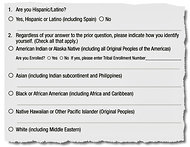HOUSTON — At the beginning of the college application season last fall, Natasha Scott, a high school senior of mixed racial heritage in Beltsville, Md., vented about a personal dilemma on College Confidential, the go-to electronic bulletin board for anonymous conversation about admissions.
Race Remixed
On College Forms, a Question of Race, or Races, Can Perplex

Natasha Scott has a black father and an Asian mother.
By SUSAN SAULNY and JACQUES STEINBERG
Race Remixed
Filling in the Boxes
Articles in this series explore the growing number of mixed-race Americans.
Related
-
Mixed-Race Students Wonder How Many Boxes to Check (June 14, 2011)
“I just realized that my race is something I have to think about,” she wrote, describing herself as having an Asian mother and a black father. “It pains me to say this, but putting down black might help my admissions chances and putting down Asian might hurt it.”
“My mother urges me to put down black to use AA” — African-American — “to get in to the colleges I’m applying to,” added Ms. Scott, who identified herself on the site as Clearbrooke. “I sort of want to do this but I’m wondering if this is morally right.”
Within minutes, a commenter had responded, “You’re black. You should own it.” Someone else agreed, “Put black!!!!!!!! Listen to your mom.”
No one advised marking Asian alone. But one commenter weighed in with advice that could just as well have come from any college across the country: “You can put both. You can put one. You’re not dishonest either way. Just put how you feel.”
Until this year, questions about race on most college applications were much simpler. A student who was white with a distant American Indian ancestor , for instance, would most likely have identified himself as white.
But students can now choose from a menu of new boxes of racial and ethnic categories — because the Department of Education started requiring universities this past school year to comply with a broad federal edict to collect more information about race and ethnicity. The change has made it easier for students to claim a multiracial identity — highlighting those parts of their backgrounds they might want to bring to the fore and disregarding others, as Ms. Scott considered doing with her Asian heritage.
So the number of applicants who identify themselves as multiracial has mushroomed, adding another layer of anxiety, soul- (and family-tree-) searching and even gamesmanship to the process.
The new options have forced colleges to confront thorny questions, including how to account for various racial mixes in seeking diversity on campus. Is a student applying as black and Latino more desirable in terms of diversity than someone who is white and black? Or white and Vietnamese? Should the ethnicities of one’s distant relatives be considered fair game, or just parents? And what should be done about students who skip the race question altogether — a sizable number of whom, some studies have shown, are white, and do so either in protest or out of fear that identifying as merely white could hurt rather than help their chances in this new environment?
Some scholars worry that the growth in multiracial applicants could further erode the original intent of affirmative action, which is to help disadvantaged minorities. For example, families with one black parent and one white parent are on average more affluent than families with two black parents. When choosing between two such applicants, some universities might lean toward the multiracial student because he will need less financial aid while still counting toward affirmative-action goals.
“How do we include multiracials in our view of an egalitarian society and not do it in a way that disadvantages other groups?” said Ulli K. Ryder, visiting scholar at the Center for the Study of Race and Ethnicity in America at Brown University.
In interviews, admissions officers at Rice, Stanford, Emory and Carleton, as well as other highly selective colleges and universities, said they were grappling with the imperative to give students greater freedom to describe their backgrounds while also being on the lookout for manipulation by those seeking to stretch their ties to particular races or ethnicities.
Those applicants well know that for decades, admissions offices have made it a priority to assemble a diverse student body, in part to redress the nation’s long history of discrimination in higher education but also to provide students rich opportunities to learn from peers who bring various backgrounds to campus. The onus of determining racial makeup is almost entirely on the students; the colleges do not typically seek out guidance counselors or other adults in the students’ lives for corroboration.
Michael Stravato for The New York Times
Chris Muñoz, left, the vice president for enrollment at Rice, and Tamara Siler, center, the head of minority recruitment, often discuss applicants. “I am honoring, best I can, how the students see themselves,” he said.
“You know kids are gaming the system every way they possibly can, from private counselors who write essays to massaging their statistics,” said Scott White, a college counselor at Montclair High School in New Jersey. “It comes up all the time. If one grandparent is of Spanish heritage, should this kid be getting an admissions bump?”
One woman who posted on College Confidential wanted to know if her children’s French great-grandfather, born in Algeria, would qualify her family as African-American. The consensus was no.
A Growing Category
Rice University in Houston might, given its early history, seem an unlikely place to find admissions officers wrestling with questions of race as they size up their applicants. A private and highly selective institution, it was founded in the early 1900s by a wealthy Houston businessman as an exclusively white institution, a designation it maintained through the late 1960s.
And yet these days, white students are now only 43 percent of the student body at Rice, where an applicant’s racial identification can become an admissions game changer. This can be especially true during the “committee round” in early spring, when only a few dozen slots might remain for a freshman class expected to number about 1,000.
At that stage, a core group of five to seven bleary-eyed admissions officers will convene for debate around a rectangular laminate table strewn with coffee cups and half-eaten doughnuts as the applications of those students still under consideration are projected onto a 60-inch plasma TV screen.
For most of the nearly 14,000 who applied this year, the final decision — admit or deny — was a relatively straightforward one resolved early on, based on the admissions officers’ sampling of factors like test scores, grades, extracurricular activities and recommendations.
But there are several thousand applicants whose fate might still be in limbo by the committee round because their qualifications can seem fairly indistinguishable from one another. This is when an applicant’s race — or races — might tip the balance.
“From an academic standpoint, the qualifying records, the test scores, how many AP courses, they may all look alike,” said Chris Muñoz, vice president for enrollment at Rice since 2006. “That’s when we might go and say, ‘This kid has a Spanish surname. Let’s see what he wrote about.’ Right or wrong, it can make a difference.”
How much of a difference — and whether more or less weight should be given to that student based on how many boxes were checked — is hardly clear, either at Rice or at dozens of other selective institutions.
And yet, at Rice, the chances that a multiracial applicant might be admitted have climbed over the last five years to 23 percent this year. (By contrast, the admission rate for the freshman class as a whole this year was about 19 percent.)
Adding to the confusion in admissions offices is that there is no standard definition, in higher education or elsewhere, of what it means to be mixed race. But the hundreds of colleges, including Rice, that accept the Common Application have allowed students to mark more than one box for several years now.
Over the last five years, the number of applicants to Rice who characterize themselves as of more than one race has skyrocketed to 564 from 8. Multiracial students now account for about 6 percent of the freshman class at Rice, nearly as many as those who identify themselves as “black or African-American.” (Nationally, about 3 percent of Americans identify themselves as mixed-race.)
The new federal requirements have freed some students from having to pay short shrift to some aspects of who they are, and have forced changes in how the colleges see them as well. But like Rice, some colleges had already gotten there on their own.
Before Emory University in Atlanta upgraded its computer system about a decade ago, if an applicant signaled that he or she was African-American and white, or African-American and Asian, someone in the admissions office would make the judgment call that the student was African-American because there were no set guidelines on how to define an applicant’s race.
“We had to pick one,” Jean Jordan, the dean of admission, said. “I’d say it was pretty arbitrary.” Actually, it may not have been so arbitrary. Emory, like other colleges, was acting at least in part to ensure a sizable African-American student population, which the college’s leaders consider an institutional priority.
Now, about 5 percent of its freshman class is considered mixed-race.
At Carleton College in Minnesota, there were, until recently, clear protocols intended to address the issues with which Emory was wrestling: students who signaled on their application that they were black, Hispanic and white, for example, were considered black; American Indian and white, then they were American Indian.
Now, such students would be among the nearly 9 percent of the freshman class at Carleton who are multiracial.
Within the System
Mr. Muñoz, who is ultimately responsible for Rice’s effort to promote diversity on campus, says he has been guided by the template of his own mixed-race family. He is Mexican-American, the first in his family to go to college, while his wife is of Irish descent. They have three grown children.
“I am honoring, best I can, how the students see themselves,” Mr. Muñoz said. “If they say they’re mixed, I’m not going to say, ‘Oh no, you’re black.’ I’m going to say, ‘You’re mixed.’ Isn’t that O.K.?”
And, he added, “We’re not out to play ‘gotcha.’ In all things there is an element of trust.”
Still, he acknowledges, such questions give applicants (and their families) wide latitude.
An applicant’s final determination of what to say about race is often made in consultation with a college counselor. Many counselors will convey to families that a multiracial applicant — like one who is black and Chinese — often has a better chance of being admitted to a highly selective college than those in any other racial or ethnic category.
When asked for advice by an applicant weighing whether to identify as multiracial, Mr. White, the counselor from New Jersey, said, “I just say, ‘Answer the question honestly: What do you consider yourself?’ ”
“If a kid is unsure,” he added, “I say check multiple boxes. If they’re Caucasian and African-American, I’d let them know that it would probably be beneficial to put yourself down as African-American or multiracial.”
“I’d be giving them information, not saying, ‘Do this,’ wink, wink.”
Still, Rice knows that however much it emphasizes that students should be guided by the honor principle in making such calls, some will seek to stretch the new definitions to their own gain.
“There are players out there,” said Julie Browning, the longtime dean of undergraduate admission at Rice.
Mindful of that, Rice admissions officials try to reconcile whatever boxes an applicant may have checked with the rest of the application.
For example, in its customized supplement to the Common Application, Rice asks an essay question about “the unique life experiences and cultural traditions” that a student might bring.
“If they care about their cultural heritage, it comes through,” Ms. Browning said. “If they’re lukewarm about it, and they’re trying to make it something they care about, it comes through.”
The subject of affirmative action is a personal one for Tamara Siler, the coordinator of minority recruitment in the Rice admissions office, who is black and who graduated from Rice in 1985.
She said that her grandparents and aunt had wanted to attend Rice, but could not because of its history of segregation. Ms. Siler said she realized that some students being admitted to Rice as multiracial would probably not fit the original definitions of affirmative action, but that students who categorize themselves as multiracial bring a valuable and unique perspective to campus.
“At some point I have to say we can’t fix society’s ills,” she said. “That’s not our job as an institution.”
This past spring, at least four applicants to Rice checked the box for nearly every ethnicity and race.
“For the most part,” Ms. Siler said, “whenever someone does all those boxes, we say, ‘Yeah, yeah, but how do you really live your life?’ “
But in the case of two of those applicants — a young woman from Hawaii who checked the boxes for Native Hawaiian, Asian-American and white, as well as a Californian who said she was white (Irish and German), black and affiliated with two American Indian tribes — Ms. Siler became convinced that the descriptions were accurate.
The Hawaiian student wrote her essay “partly in her native language” and “talked in detail about her other heritages as well,” Ms. Siler said. The Californian “discussed the influence of these various cultures on her family traditions, especially related to holidays.”
“Both students,” Ms. Siler said, “were admitted to Rice.”
When Mr. Muñoz was asked if, within the multiracial pool, there is a hierarchy of sorts for getting an edge in the admissions process, he took a long pause.
“That’s hard,” he said.
“Not in an intentional way, but it’s just the reality. I don’t sit with my group and say, O.K., Japanese-American is going to be treated this way, African-American-Hispanic is going to be treated this way,” he said. “It’s part of, what’s the story? How underrepresented is this group on campus?”
“At any point in time,” he concluded, “the given weights of what you’d consider to be important change.”
At her magnet school in Maryland, Natasha Scott, the student who posted about applying as Asian or black on the Web site College Confidential, typically identified as both races. On her applications, however, she ultimately chose to mark only one box: black.
“I think that when you’re a stressed out high school senior, you’ll do anything that’s legal to get into college,” said Ms. Scott, 16, who will be attending the University of Virginia. “I must admit that I felt a little guilty only putting black because I was purposely denying a part of myself in order to look like a more appealing college candidate.”
But, she continued, “In any case, I think it’s up to the individual.”


